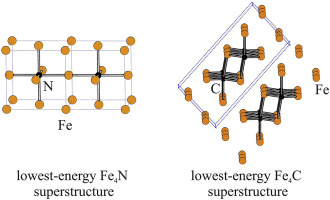当前位置:
X-MOL 学术
›
Acta Mater.
›
论文详情
Our official English website, www.x-mol.net, welcomes your
feedback! (Note: you will need to create a separate account there.)
Crystal structures of Fe 4 C vs. Fe 4 N analysed by DFT calculations: Fcc-based interstitial superstructures explored
Acta Materialia ( IF 8.3 ) Pub Date : 2017-11-01 , DOI: 10.1016/j.actamat.2017.08.059 A. Leineweber , T. Hickel , B. Azimi-Manavi , S.B. Maisel
Acta Materialia ( IF 8.3 ) Pub Date : 2017-11-01 , DOI: 10.1016/j.actamat.2017.08.059 A. Leineweber , T. Hickel , B. Azimi-Manavi , S.B. Maisel

|
Abstract Knowledge of the thermodynamic and structural properties of iron carbide and nitride phases is crucial for understanding phase transformations and related microstructure formation in steels. While the existence and crystal structure of the primitive cubic fcc-based γ′-Fe 4 N 1- z phase is experimentally well-established, there is no consensus in contemporary literature about an analogous γ′-Fe 4 C compound. Here, we present DFT calculations for all fcc-like Fe 4 C and Fe 4 N superstructures with up to two formula units per primitive unit cell, providing energy values and the relaxed atomic structures, which were analysed mathematically and by visual inspection of the atomic arrangement. Notably, all considered Fe 4 C and Fe 4 N superstructures are metastable with respect to α-Fe and cementite-Fe 3 C/e-Fe 3 N. Unsurprisingly, we find the well-known γ′ compound's crystal structure to be most favourable among these metastable Fe 4 N superstructures. However, we find the equivalent superstructure to be quite unfavourable in Fe 4 C. The most favourable among these metastable Fe 4 C structures are stabilised by a partial Bain-like distortion into the direction of a body-centred cubic arrangement of Fe atoms. This makes the particular C-ordering interesting for comparison with the short-range order in Fe-C martensites. However, even the lowest-energy Fe 4 C structure releases about 0.056 eV/atom upon decomposition into α + Fe 3 C, much more than it is the case for Fe 4 N (0.019 eV/atom). That energy difference is difficult to overcome even at T > 0 K, in agreement with the lack of clear experimental evidence for existence of a Fe 4 C phase.
中文翻译:

通过 DFT 计算分析 Fe 4 C 与 Fe 4 N 的晶体结构:探索基于 Fcc 的间隙超结构
摘要 碳化铁和氮化铁相的热力学和结构特性对于理解钢中的相变和相关微观结构形成至关重要。虽然原始立方 fcc 基 γ'-Fe 4 N 1-z 相的存在和晶体结构在实验上已经很好地建立,但当代文献中没有关于类似的 γ'-Fe 4 C 化合物的共识。在这里,我们展示了所有类似 fcc 的 Fe 4 C 和 Fe 4 N 超结构的 DFT 计算,每个原始晶胞最多两个公式单元,提供能量值和松弛的原子结构,这些值通过数学分析和原子的目视检查安排。值得注意的是,所有考虑的 Fe 4 C 和 Fe 4 N 超结构对于 α-Fe 和渗碳体-Fe 3 C/e-Fe 3 N 都是亚稳态的。不出所料,我们发现众所周知的 γ' 化合物的晶体结构在这些亚稳态 Fe 4 N 超结构中是最有利的。然而,我们发现等效超结构在 Fe 4 C 中非常不利。这些亚稳态 Fe 4 C 结构中最有利的通过向 Fe 原子体心立方排列方向的部分贝恩样畸变稳定。这使得特定的 C 有序与 Fe-C 马氏体中的短程有序进行比较很有趣。然而,即使是能量最低的 Fe 4 C 结构在分解为 α + Fe 3 C 时也会释放约 0.056 eV/原子,远高于 Fe 4 N(0.019 eV/原子)的情况。即使在 T > 0 K 时也难以克服能量差异,这与缺乏明确的 Fe 4 C 相存在的实验证据一致。在这些亚稳态 Fe 4 N 超结构中,s 晶体结构是最有利的。然而,我们发现等效超结构在 Fe 4 C 中非常不利。这些亚稳态 Fe 4 C 结构中最有利的通过向 Fe 原子体心立方排列方向的部分贝恩样畸变稳定。这使得特定的 C 有序与 Fe-C 马氏体中的短程有序进行比较很有趣。然而,即使是能量最低的 Fe 4 C 结构在分解为 α + Fe 3 C 时也会释放约 0.056 eV/原子,远高于 Fe 4 N(0.019 eV/原子)的情况。即使在 T > 0 K 时,这种能量差异也难以克服,这与缺乏明确的 Fe 4 C 相存在的实验证据一致。在这些亚稳态 Fe 4 N 超结构中,s 晶体结构是最有利的。然而,我们发现等效超结构在 Fe 4 C 中非常不利。这些亚稳态 Fe 4 C 结构中最有利的通过向 Fe 原子体心立方排列方向的部分贝恩样畸变稳定。这使得特定的 C 有序与 Fe-C 马氏体中的短程有序进行比较很有趣。然而,即使是能量最低的 Fe 4 C 结构在分解为 α + Fe 3 C 时也会释放约 0.056 eV/原子,远高于 Fe 4 N(0.019 eV/原子)的情况。即使在 T > 0 K 时,这种能量差异也难以克服,这与缺乏明确的 Fe 4 C 相存在的实验证据一致。
更新日期:2017-11-01
中文翻译:

通过 DFT 计算分析 Fe 4 C 与 Fe 4 N 的晶体结构:探索基于 Fcc 的间隙超结构
摘要 碳化铁和氮化铁相的热力学和结构特性对于理解钢中的相变和相关微观结构形成至关重要。虽然原始立方 fcc 基 γ'-Fe 4 N 1-z 相的存在和晶体结构在实验上已经很好地建立,但当代文献中没有关于类似的 γ'-Fe 4 C 化合物的共识。在这里,我们展示了所有类似 fcc 的 Fe 4 C 和 Fe 4 N 超结构的 DFT 计算,每个原始晶胞最多两个公式单元,提供能量值和松弛的原子结构,这些值通过数学分析和原子的目视检查安排。值得注意的是,所有考虑的 Fe 4 C 和 Fe 4 N 超结构对于 α-Fe 和渗碳体-Fe 3 C/e-Fe 3 N 都是亚稳态的。不出所料,我们发现众所周知的 γ' 化合物的晶体结构在这些亚稳态 Fe 4 N 超结构中是最有利的。然而,我们发现等效超结构在 Fe 4 C 中非常不利。这些亚稳态 Fe 4 C 结构中最有利的通过向 Fe 原子体心立方排列方向的部分贝恩样畸变稳定。这使得特定的 C 有序与 Fe-C 马氏体中的短程有序进行比较很有趣。然而,即使是能量最低的 Fe 4 C 结构在分解为 α + Fe 3 C 时也会释放约 0.056 eV/原子,远高于 Fe 4 N(0.019 eV/原子)的情况。即使在 T > 0 K 时也难以克服能量差异,这与缺乏明确的 Fe 4 C 相存在的实验证据一致。在这些亚稳态 Fe 4 N 超结构中,s 晶体结构是最有利的。然而,我们发现等效超结构在 Fe 4 C 中非常不利。这些亚稳态 Fe 4 C 结构中最有利的通过向 Fe 原子体心立方排列方向的部分贝恩样畸变稳定。这使得特定的 C 有序与 Fe-C 马氏体中的短程有序进行比较很有趣。然而,即使是能量最低的 Fe 4 C 结构在分解为 α + Fe 3 C 时也会释放约 0.056 eV/原子,远高于 Fe 4 N(0.019 eV/原子)的情况。即使在 T > 0 K 时,这种能量差异也难以克服,这与缺乏明确的 Fe 4 C 相存在的实验证据一致。在这些亚稳态 Fe 4 N 超结构中,s 晶体结构是最有利的。然而,我们发现等效超结构在 Fe 4 C 中非常不利。这些亚稳态 Fe 4 C 结构中最有利的通过向 Fe 原子体心立方排列方向的部分贝恩样畸变稳定。这使得特定的 C 有序与 Fe-C 马氏体中的短程有序进行比较很有趣。然而,即使是能量最低的 Fe 4 C 结构在分解为 α + Fe 3 C 时也会释放约 0.056 eV/原子,远高于 Fe 4 N(0.019 eV/原子)的情况。即使在 T > 0 K 时,这种能量差异也难以克服,这与缺乏明确的 Fe 4 C 相存在的实验证据一致。











































 京公网安备 11010802027423号
京公网安备 11010802027423号